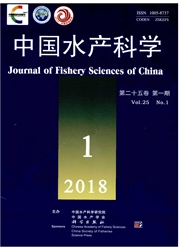

 中文摘要:
中文摘要:
为了研究半滑舌鳎(Cynoglossus semilaevis)不同家系肌肉中脂肪酸的组成与含量,并选育出高营养品系的半滑舌鳎家系,用气相色谱法对同一养殖环境中的半滑舌鳎15个不同家系(164个样本)肌肉中的脂肪酸的组成和含量进行了检测和比较分析,同时对高EPA、DHA、EPA+DHA含量的家系进行筛选,并研究了半滑舌鳎性别与EPA、DHA含量的关系。结果表明:(1)15个家系肌肉中脂肪酸种类没有区别,但脂肪酸的组成和含量存在若干差异。其特征均为多不饱和脂肪酸(PUFA)〉饱和脂肪酸(SFA)〉单不饱和脂肪酸(MUFA)。PUFA以ω-3系脂肪酸为主,且ω-3系脂肪酸与ω-6系脂肪酸比值达到4.16~5.03,其中的2种重要ω-3系脂肪酸EPA和DHA在15个家系中均具有显著性差异,且DHA含量远大于EPA含量;筛选出了3个高EPA、DHA、EPA+DHA含量家系,分别为F13012、F13023及F13031。(2)EPA的含量与半滑舌鳎性别不具有显著性相关关系。本研究对于选育半滑舌鳎优良品种家系具有重要意义。
 英文摘要:
英文摘要:
Half smooth tongue sole(Cynoglossus semilaevis) is a large bottom-dwelling fish that lives in warm water, mainly distributed along the coast of the Bohai Sea and Yellow Sea in China. The half smooth tongue sole is large, grows fast, has a favorable flesh quality and high economic value, and is appreciated by consumers. EPA and DHA are ?-3 polyunsaturated fatty acids that are appreciated for their nutritional and human health values. Pregnant and breastfeeding woman require ?-3 polyunsaturated fatty acids in their diet to promote their baby's development. EPA and DHA lower the incidence of type II diabetes mellitus, hypertension, atherosclerosis and inflammation. Although alphalinolenic acid may be used as a raw material to synthesize EPA and DHA, increasing age and pathological factors mean that the amount of synthesized ω-3 polyunsaturated fatty acids may be insufficient for some tissues and organs, and must be obtained from food intake. Natural aquatic products are very important sources of EPA and DHA. Therefore, it is necessary to determine the EPA and DHA contents to improve farmed fish quality. To study the composition and content of fatty acids in muscles of different half smooth tongue sole families and bred strains, 164 samples from 15 different half smooth tongue sole families were cultivated in the same environment. The muscle fatty acid composition and content of the 164 samples were tested using a gas chromatograph and analyzed comparatively to identify families with high contents of EPA, DHA and EPA+DHA, and to study the relationship between gender and the contents of EPA, DHA and EPA+DHA. There were no significant differences in patterns and types of fatty acids among the different families, while there were significant differences in fatty acid contents. The fatty acid content characteristic of all families was the same: PUFA(polyunsaturated fatty acids)〉SFA(saturated acids)〉MUFA(monounsaturated fatty acids). The predominant PUFAs were ?-3 polyunsaturated fatty a
 同期刊论文项目
同期刊论文项目
 同项目期刊论文
同项目期刊论文
 期刊信息
期刊信息
